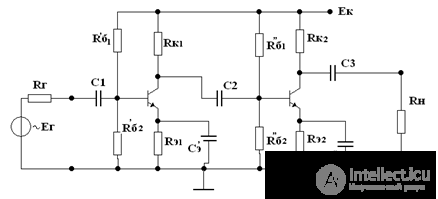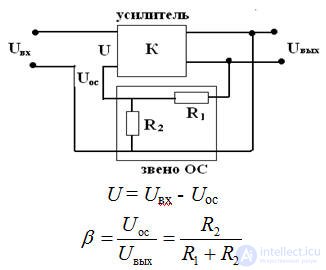Lecture
Multi-stage amplifiers
Amplifiers, consisting of several stages, designed to increase the gain, called multi-stage amplifiers. 
The connection between the amplifying cells of a multistage amplifier is carried out in various ways:
• the input of the next amplifying stage is connected to the output of the previous one with the help of resistors - direct (galvanic) communication;
• the input of the next amplifying stage is connected to the output of the previous one through the coupling capacitor Cc and the resistor Rc connected in parallel to the input of the subsequent amplifying stage - rheostatic-capacitive coupling.
Two stage amplifier 
Gain voltage for medium frequencies K = K1 * K2 * ... Kn. 
Dividers give a decrease in the overall gain several times, usually in 3-5. This should be considered when designing an amplifier.
• With an increase in the number of stages, the frequency distortion coefficient will be determined by the formula:
M = M1 • M2 ...,
if the number of cascades is n, then M will increase by n times.
• Phase of the output signal: φ = φ1 + φ2 + ...
• the gain increases, but the bandwidth is narrowed.
For a two-stage amplifier: the frequency distortion factor will increase by 2 times, and the phase of the output signal will be equal to the phase of the input signal

Comments
To leave a comment
Electronics, Microelectronics, Element Base
Terms: Electronics, Microelectronics, Element Base